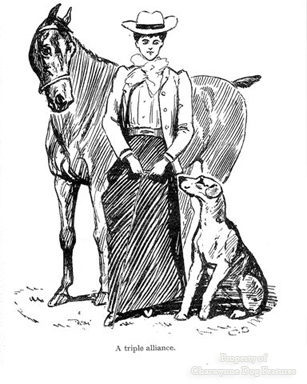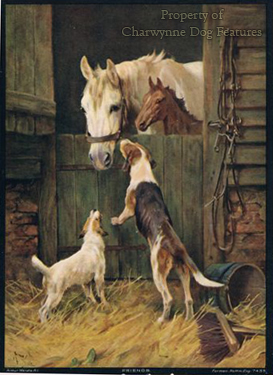465 Horse & Hound
MAN,HORSE AND HOUND : A PRECIOUS TRINITY
by David Hancock
 Man's abiding friendship with horse and with dog has inspired hundreds of paintings and millions of words. But dog's friendship with horse has attracted rather less coverage. The timeless trinity, man, dog, horse, has featured across the globe in just about every century of recorded history. The bilateral relationship between dog and horse has however been given less attention than that between man and each of them. Man may have brought horse and dog together but dog and horse are much more likely to share the stable! This four-legged friendship has long been a precious one, but as horse-drawn vehicles steadily gave way to motor vehicles, the stable relationship became a victim of change. Now, with a firm question mark over hunting with dogs in the future, the close relationship between horse and hound looks likely to go that way too. This threatens the future relationship between horse and dog too; man's activities are the catalyst.
Man's abiding friendship with horse and with dog has inspired hundreds of paintings and millions of words. But dog's friendship with horse has attracted rather less coverage. The timeless trinity, man, dog, horse, has featured across the globe in just about every century of recorded history. The bilateral relationship between dog and horse has however been given less attention than that between man and each of them. Man may have brought horse and dog together but dog and horse are much more likely to share the stable! This four-legged friendship has long been a precious one, but as horse-drawn vehicles steadily gave way to motor vehicles, the stable relationship became a victim of change. Now, with a firm question mark over hunting with dogs in the future, the close relationship between horse and hound looks likely to go that way too. This threatens the future relationship between horse and dog too; man's activities are the catalyst.
Dogs and horses have experienced both the affection and use by man and the concurrent cruelty and misuse by man. In his Brutes and Beasts (Noel Douglas, 1933), John Swain summarised use and misuse. "Dogs have been used for the gratification of man in nearly all sports; run off their feet in hunting; disembowelled in bull-baiting; torn or hugged to death in the bear-rings; and bitten to death in forced dog-fights. They aided their masters in war, and died for them willingly. Not only in ancient times, but today." In 1914 the Germans had 6,000 war dogs, we had none. We caught up fast! It is estimated that around 7,000 British war dogs lost their lives by the end of the Great War.
Swain writes on horses too: "No animal has been used more in the service of man. If the dog has been man's companion and guardian, the horse has been man's slave." In 1835, the result of the Derby was conveyed to central London from Epsom by a reporter of the Sun newspaper on a horse. This horse was thrashed and spurred without mercy until it collapsed exhausted on Waterloo bridge: it died later that evening. A few years later a mare was ridden from Leamington to London, roughly one hundred miles, in under twelve hours: she died soon after. The horsemen of the steppes, for a journey of that distance would have used a team of three horses for the same rider - and we called them barbarians!
Half a century before the sad death of this misused mare, James Granger was recording: "It hath been observed that there is no country upon the face of the whole earth that is not totally sunk in barbarism where this beast is so ill-treated, as it is in our own: hence England is proverbially called 'The Hell of Horses' ". Similar words were used to condemn cruelty towards draught-dogs. In the debate on a nineteenth century bill to ban dog-carting, the Bishop of Oxford spoke of a case where the route of the dog could be traced by following its twenty mile blood-trail on the highway. It was not unusual for dogs to pull a heavy cart for 40-50 miles on hard-surfaced roads. One exhausted dog was witnessed being dismembered and then fed to two other draught dogs.
In the 'sporting' field the abuse of both dogs and horses was commonplace. The great fox-hunter Beckford, writing in 1780, stated that the common practice of flogging hounds in kennels is 'unreasonably unjust and cruel, carried to excess, as we sometimes see, it is a disgrace to humanity.' After one four-hour run during a stag-hunt in the 19th century a report described how 'one horse dropped dead, another died before he could reach a stable and seven more within the week.' Long exploited by man, there must have been more than a little empathy and fellow-feeling when dog and horse shared the same stable. The two species share similar characteristics: honesty, loyalty, a willingness to work, a natural dignity and an uncomplaining nature. Both share a humble need for exercise, daily care, good nutrition and the occasional show of affection towards them. Dog has long been willing to guard horses.
When I was living and working in Ireland in the late 1960s, an Irish racehorse owner told me he always employed Irish Terriers both to guard his stables and to keep the rats down in them. He stressed the need for dogs used in this role to have a great affinity with horses, together with a highly developed protective urge towards them. He pointed out that the dogs guarded the horses not the stables and at night elected to sleep where they could be close to the horses. I have heard of hunt terriers, Manchester Terriers and Bull Terriers with similar traits. The horse-dog affinity is a strong one and stronger in some terrier breeds, as well as in the Dalmatian.
In the hunting field horse and hound have each been shaped by man in different ways but to a common purpose. The Foxhound for example has evolved from a longer-eared slower-paced Southern Hound type of scenthound to the streamlined steeplechaser of today. This has been achieved using the blood of the Greyhound, the Harrier, the Welsh Foxhound, the Fell Hound and the American Foxhound. The horse was changed substantially in the eighteenth century when enclosed land by way of fences meant that horses had to jump in the chase. The types available varied from the palfry, the newly-developed thoroughbred, the Arab and the heavier Dutch type, once used to carry knights in armour. Mounted hunters soon discovered that a composite, what became known as the three-quarter-bred hunter, provided the best steeplechaser. Strangely, those advocating massive bone in Foxhounds just over a century ago did not seek a similar property in the horses they rode to follow those hounds.
Dog has suffered more than horse as a victim of man's whims over their design. But both are about to suffer a severe drop in their numbers as, paradoxically, animal welfare campaigns decide their future. Stables empty of both will no doubt go the way of barns and become transformed into human dwellings, so ending a long intimate association between horse and dog. This in turn will change the countryside, much of which has been shaped by field sports. But sadly there might be a role for the hunter and the hound in utilising their skill together to track down and humanely destroy foxes maimed by shotgun-wielding vermin-controllers, provided this does not lead them to breach the new laws. Dog, horse and fox are all man's victims. Animals classified by man as vermin causing animals developed by man to control them being destroyed? Rowlandson, the hunt cartoonist, would have been inspired by such a pantagruelian opportunity.
Dogs care enough about horses to protect them in their stables; horses care enough about dogs to avoid stepping on them when the pack surrounds them. I have heard of cases in which a local dog has joined the pack at a meet to sniff around the horses' feet and received a warning kick in response. A horse, due to the positioning of its eyes, has good all-round vision but is unlikely, with its head up, to be able to see a dog at its hind feet. How does it detect the unwanted dog? How does it avoid treading on the hounds when they are milling around its hooves? And, more importantly, why does the horse not object to having the pack so close to its feet? Undoubtedly, familiarity plays a part; the horse does not feel threatened by the hounds and the senior hounds dictate the attitude of the tyro-hounds to horses. But their compatibility is still remarkable.
It is no accident that those, like the Alans and the Arabs for example, who had superlative horses also had superlative hounds. It is worth noting that the Alans, famous for their powerful hunting mastiffs or alauntes, were praised in Roman times for their small swift horses. The governors of Milan were once commended for rearing 'Alanian dogs of high stature and wonderful courage.' The Arabs are world-renowned for their superb horses and outstanding sighthounds. Libyan horses and hounds were highly rated by the Romans.
Medieval artists used the dog to symbolise fidelity and the horse to represent honesty and courage in their paintings. This high regard has survived down through the centuries. More recently, the timeless tripartite team of man, horse and dog has survived the growth of towns, the introduction of the railways, the invention of the motor-car, two world wars, the decline of agriculture and wholescale changes to the human lifestyle. Some pessimists see the banning of hunting with dogs as heralding the break-up of the precious man-horse-dog relationship; certainly some rural areas will change forever and all breeds of hunting dogs will be significantly affected too. The physical mutilation of the latter which accompanied King Canute's Forest Laws may one day prove to have been less harmful, however appalling, in the long run than those enacted one thousand years later. As far as our long-established packhounds are concerned, misguided kindness can - after a long pursuit - kill! For 'Hunting with Dogs Act' read 'Killing the Hounds Act'!